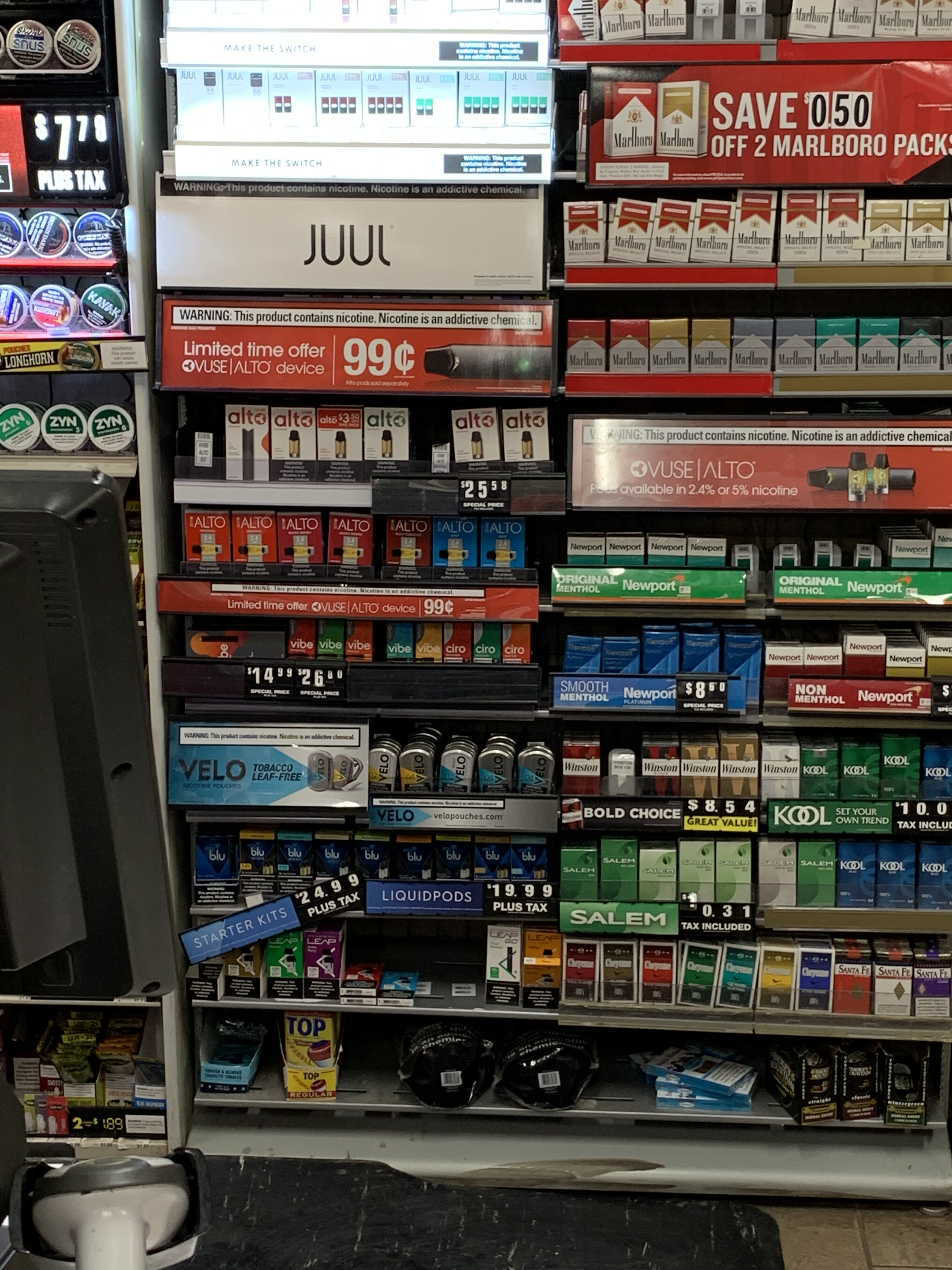Welcome to CounterTobacco.org’s “News and Research Roundup!” Each month we post a summary of the latest research, reports, and news stories on counteracting tobacco product sales and marketing at the point of sale (POS). Keeping up with what’s happening in the POS movement all across the country can help you choose policies and strategies that work best for your community. New research can help provide support for your work and evidence for the importance of the “War in the Store.” Have a story you don’t want us to miss? E-mail it to us!
New Research
Tobacco Retailer Density
- Retailer density reduction approaches to tobacco control: A review, Health & Place
- A review of the international evidence on tobacco retailer reduction policies found “strong preliminary evidence to support certain retailer reduction policies” and that combining types of policies (e.g. a retailer cap and a prohibiting retailers near schools) is most effective. Evidence shows that policies prohibiting the sale of tobacco in pharmacies can reduce density overall but may maintain or exacerbate disparities, while prohibiting tobacco retailers near schools reduces density to a greater degree in higher-risk neighborhoods. Additional research is needed to show the long-term impact of reducing retailer density on tobacco use behaviors, which can take several years to see change.
- Learn more about tobacco retailer density.
- Neighborhood Inequities in Tobacco Retailer Density and the Presence of Tobacco-Selling Pharmacies and Tobacco Shops, Health Education & Behavior
 Based on 2018 list of probable tobacco retailers in the United States, researchers found that census tracts with a greater percentage of residents who are low-income had higher tobacco retailer density regardless of how density was measured (e.g. number of tobacco retailers per population, per land area, per kilometer of roadway). However, the association with density varied across types of density measures for census tracts with a higher percentage of people who are Black, Hispanic or Latino, and where there is more vacant housing. Census tracts with a greater proportion of people who are Black were less likely to have a pharmacy or a tobacco shop, while census tracks with a greater proportion of people who are low income were more likely to have a tobacco shop. These findings are important to keep in mind when considering the equity impact of retailer reduction policies.
Based on 2018 list of probable tobacco retailers in the United States, researchers found that census tracts with a greater percentage of residents who are low-income had higher tobacco retailer density regardless of how density was measured (e.g. number of tobacco retailers per population, per land area, per kilometer of roadway). However, the association with density varied across types of density measures for census tracts with a higher percentage of people who are Black, Hispanic or Latino, and where there is more vacant housing. Census tracts with a greater proportion of people who are Black were less likely to have a pharmacy or a tobacco shop, while census tracks with a greater proportion of people who are low income were more likely to have a tobacco shop. These findings are important to keep in mind when considering the equity impact of retailer reduction policies.- Learn more about tobacco retailer density.
- Brief report: Tobacco mythbusting – tobacco is not a major driver of foot traffic in low socio-economic small retail stores, Tobacco Control
- This study conducted by surveying consumers outside of small stores selling tobacco in lower socioeconomic areas in Australia found that only 3% of consumers reporting purchasing tobacco as the primary reason for visiting the store and only 8% of consumers purchased any tobacco products. This shows that, contrary to industry claims, tobacco is not a key driver of consumer foot traffic for small retailers. In addition, consumers who did not purchase tobacco products made greater planned purchases of non-tobacco products and an equal amount of unplanned purchases of non-tobacco products compared to consumer who purchased tobacco. This also is in contrast to the industry claim that tobacco purchases lead to other product purchases in stores.
Menthol and Other Flavored Tobacco Products
- Evaluating the impact of menthol cigarette bans on cessation and smoking behaviours in Canada: longitudinal findings from the Canadian arm of the 2016-2018 ITC Four Country Smoking and Vaping Surveys, Tobacco Control
- After Canada’s 2017 implementation of a ban on menthol cigarettes, a study found that of people who smoked menthol cigarettes before the ban, 59.1% switched to non-menthol cigarettes, 21.5% quit smoking, and 19.5% smoked menthols purchased from First Nations reserves. During this time, people who smoked menthol had higher quit attempt rates and quit success than people who smoked non-menthol cigarettes.
- News story: Canada-wide ban on menthol cigarettes leads to significant increases in quitting among smokers, EurekAlert!
- Canada’s Menthol Cigarette Ban Boosted Quit Rates: Would the Same Happen in U.S.?
- Learn more about menthol.
COVID-19
- E-Cigarette Use Among Youths and Young Adults During the COVID-19 Pandemic: United States, 2020, AJPH
- Comparing March 14 – June 29, 2020 following COVID-19 “stay at home” orders with the same period the previous year, researchers found that odds of current e-cigarette use were lower among youth ages 15-17 years and among young adults ages 18-20 years. People who use e-cigarettes and reported reduced access to retail environments due to the lockdowns had higher odds of reporting reduced e-cigarette use.
- Truth Initiative article: Youth vaping declines during pandemic as young people report less retail and social access to products
- Multi-level drivers of tobacco use and purchasing behaviors during COVID-19 “lockdown”: A qualitative study in the United States, International Journal of Drug Policy
- Between April and May 2020 during COVID-19 pandemic “stay at home” orders, interviews with 44 adults show that tobacco use patterns varied. While most users increased use due to factors like anxiety, boredom, and irregular routines, social users decreased use. While cigarettes remained available in the retail environment, access to ENDS was limited, which led some people to purchase them online and to use cigarettes when deliveries were delayed. The authors conclude, “To mitigate ways that the COVID-19 pandemic may exacerbate an existing public health crisis, multi-level policy strategies, such as expanded virtual cessation services and implementation and enforcement of smoke-free home rules, can better support population health during this critical period. Policies that facilitate access to lower risk products can help minimize harm among those who cannot or do not want to quit smoking.”
E-Cigarettes
- Rural-Urban Differences in Changes and Effects of Tobacco 21 in Youth E-Cigarette Use, Pediatrics
- Data from statewide 2018 -2019 surveys in Kansas show that e-cigarette use increased among youth across the board, but increases in use were greater among youth living in rural areas. However, in places where Tobacco 21 policies were implemented, increases in use were smaller.
- Learn more about rural tobacco disparities at the point of sale.
 ‘Give ‘em the vape, sell ‘em the pods’: a razor-and-blades method of pod e-cigarette pricing, Tobacco Control
‘Give ‘em the vape, sell ‘em the pods’: a razor-and-blades method of pod e-cigarette pricing, Tobacco Control
- Researchers describe a pricing strategy used by e-cigarette manufacturers selling the pod device for cheap and relying on the profits from the e-liquid-filled cartridges or “pods.” The authors discuss how this strategy may encourage smokers to try switching to vaping, encourage uptake of vaping among young people, encourage people who currently use refillable e-cigarettes to switch to pod devices, and widen smoking-related economic inequalities.
- Learn more about e-cigarettes at the point of sale.
- Respiratory Symptom Incidence Among People Using Electronic Cigarettes, Combustible Tobacco, or Both, American Journal of Respiratory and Critical Care Medicine
- News story: Use of e-cigarettes plus tobacco cigarettes linked to higher risk of respiratory symptoms, EurekAlert!
Heated Tobacco Products
- Impact of chronic use of heat-not-burn cigarettes on oxidative stress, endothelial dysfunction and platelet activation: the SUR-VAPES Chronic Study, Thorax
- News story: Cellular impact of ‘Heat not Burn’ products may be no less harmful than cigarettes, EurekAlert!
- Special communication: FDA’s reduced exposure marketing order for IQOS: why it is not a reliable global model, Tobacco Control
- This article explores how Philip Morris International has exploited the FDA’s approval of a “modified risk tobacco product” marketing order for the heated tobacco product IQOS, using it for marketing purposes internationally and to advocate for other countries to reverse policies that restrict sales and marketing of heated tobacco products.
- Learn more about heated tobacco products at the point of sale.
New Reports
- Federal Trade Commission Cigarette Report for 2019
- Federal Trade Commission Smokeless Tobacco Report for 2019
- ChangeLab Solutions’ Addressing Tobacco Related Health Inequities
- CDC OSH’s Scientific Evidence Briefs:
Industry News
- 5 Areas of Regulation Taunting Tobacco, CSP Daily News
- When It Comes to Tobacco, C-store Operators Must Be Masters in Adaptation, Convenience Store News
- Altria Gives Insights on Noncombustible Strategy, CSP Daily News
POS Policy in the Media
Menthol and Other Flavored Tobacco Products
- FDA weighs ban on menthol cigarettes, which disproportionately addict – and kill – Black Americans, Washington Post
- Civil rights and Black health organizations press Biden administration to ban menthol cigarettes, Washington Post
- [CA] Reynolds Loses Bid to Scrap San Diego Ban on Tobacco Flavors, Bloomberg Law
- [NC] The tobacco industry targets Black smokers with menthol. The FDA should ban it. Herald Sun
- [ME] Maine Voices: For equity and justice, it’s time to end sale of flavored tobacco in Maine, Press Herald
Tobacco Retailer Licensing
- [CA] Crescent City Mulls Tobacco Retail License, Calls for More Research, Wild Rivers Outpost
- [NY] County may create licensing for those that sell tobacco, Post-Journal
Endgame
- [MN] Bloomington to end sales of flavored tobacco, sunset all tobacco licenses, KSTP
- [MA] New Tobacco Regulations Prohibits Smoking, Vaping In Public; Restricts Sales, The Falmouth Enterprise
- An end to cigarettes? New Zealand aims to create smoke-free generation, Guardian
Preemption
- [MO] Missouri legislature works to increase tobacco age to 21 to reflect federal law, KOAM News
- [MT] Bill that would stop local governments from banning flavored vapes revived, Independent Record
- [SC] Bill banning local rules that limit tobacco sales advancing in SC House, Post and Courier
- [FL] Tobacco 21 bill clears House despite preemption objections, Florida Politics
Other
- [AL] Alabama House passes bill banning sales of e-cigarettes to people under 21, com
- [OH] Brunswick council mulls tobacco point-of-sale advertising legislation, com
- Biden administration eyes reducing nicotine in cigarettes: report, The Hill
Find more stories in last month’s News and Research Roundup.
Know of a story that we missed? Email us, and we’ll be sure to include it in next month’s roundup!


